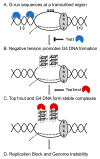The Functional Consequences of Eukaryotic Topoisomerase 1 Interaction with G-Quadruplex DNA
- PMID: 32059547
- PMCID: PMC7073998
- DOI: 10.3390/genes11020193
The Functional Consequences of Eukaryotic Topoisomerase 1 Interaction with G-Quadruplex DNA
Abstract
Topoisomerase I in eukaryotic cells is an important regulator of DNA topology. Its catalytic function is to remove positive or negative superhelical tension by binding to duplex DNA, creating a reversible single-strand break, and finally religating the broken strand. Proper maintenance of DNA topological homeostasis, in turn, is critically important in the regulation of replication, transcription, DNA repair, and other processes of DNA metabolism. One of the cellular processes regulated by the DNA topology and thus by Topoisomerase I is the formation of non-canonical DNA structures. Non-canonical or non-B DNA structures, including the four-stranded G-quadruplex or G4 DNA, are potentially pathological in that they interfere with replication or transcription, forming hotspots of genome instability. In this review, we first describe the role of Topoisomerase I in reducing the formation of non-canonical nucleic acid structures in the genome. We further discuss the interesting recent discovery that Top1 and Top1 mutants bind to G4 DNA structures in vivo and in vitro and speculate on the possible consequences of these interactions.
Keywords: G-quadruplex; genome instability; topoisomerase I.
Conflict of interest statement
The authors declare that there are no conflicts of interests.
Figures


Similar articles
-
The role of topoisomerase I in suppressing genome instability associated with a highly transcribed guanine-rich sequence is not restricted to preventing RNA:DNA hybrid accumulation.Nucleic Acids Res. 2016 Jan 29;44(2):718-29. doi: 10.1093/nar/gkv1152. Epub 2015 Nov 2. Nucleic Acids Res. 2016. PMID: 26527723 Free PMC article.
-
The Top1 paradox: Friend and foe of the eukaryotic genome.DNA Repair (Amst). 2017 Aug;56:33-41. doi: 10.1016/j.dnarep.2017.06.005. Epub 2017 Jun 9. DNA Repair (Amst). 2017. PMID: 28641942 Free PMC article. Review.
-
G-quadruplexes on chromosomal DNA negatively regulates topoisomerase 1 activity.Nucleic Acids Res. 2024 Mar 21;52(5):2142-2156. doi: 10.1093/nar/gkae073. Nucleic Acids Res. 2024. PMID: 38340342 Free PMC article.
-
Topoisomerase I plays a critical role in suppressing genome instability at a highly transcribed G-quadruplex-forming sequence.PLoS Genet. 2014 Dec 4;10(12):e1004839. doi: 10.1371/journal.pgen.1004839. eCollection 2014 Dec. PLoS Genet. 2014. PMID: 25473964 Free PMC article.
-
Genomes and G-quadruplexes: for better or for worse.J Mol Biol. 2013 Nov 29;425(23):4782-9. doi: 10.1016/j.jmb.2013.09.026. Epub 2013 Sep 25. J Mol Biol. 2013. PMID: 24076189 Review.
Cited by
-
Low-frequency vibrational modes in G-quadruplexes reveal the mechanical properties of nucleic acids.Phys Chem Chem Phys. 2021 Jun 21;23(23):13250-13260. doi: 10.1039/d0cp05404f. Epub 2021 Jun 4. Phys Chem Chem Phys. 2021. PMID: 34095914 Free PMC article.
-
G-quadruplex-R-loop interactions and the mechanism of anticancer G-quadruplex binders.Nucleic Acids Res. 2020 Dec 2;48(21):11942-11957. doi: 10.1093/nar/gkaa944. Nucleic Acids Res. 2020. PMID: 33137181 Free PMC article. Review.
-
Dual Targeting Topoisomerase/G-Quadruplex Agents in Cancer Therapy-An Overview.Biomedicines. 2022 Nov 15;10(11):2932. doi: 10.3390/biomedicines10112932. Biomedicines. 2022. PMID: 36428499 Free PMC article. Review.
-
Cleavage-defective Topoisomerase I mutants sharply increase G-quadruplex-associated genomic instability.Microb Cell. 2022 Jan 31;9(3):52-68. doi: 10.15698/mic2022.03.771. eCollection 2022 Mar 7. Microb Cell. 2022. PMID: 35291312 Free PMC article.
-
Robust Computational Approaches to Defining Insights on the Interface of DNA Repair with Replication and Transcription in Cancer.Methods Mol Biol. 2022;2444:1-13. doi: 10.1007/978-1-0716-2063-2_1. Methods Mol Biol. 2022. PMID: 35290628 Free PMC article.
References
Publication types
MeSH terms
Substances
LinkOut - more resources
Full Text Sources
Medical
Research Materials

